| The first schools in Darlaston were
Sunday schools, founded by local churches. Shaw in his
Staffordshire history mentions the following: A school was
built in 1793 in the churchyard and had a large number
of pupils. Sunday schools were first established here in
1790 and are supported by voluntary subscriptions, and
about £10 which is annually collected at the church on
the Wake Sunday, the Sunday after St. Lawrence, when
sermons are preached for that purpose.
In 1818 the Select Committee into
the Education of the Poor produced a report into the
extent of education in Darlaston. It stated that there
were day schools with 365 boys and girls, and Sunday
schools with 180 boys and girls. All supported by
subscriptions. The report concluded that:
The poorer classes are more than
commonly destitute of the means of educating their
children, and are so desirous of them, that the rector
is endeavoring to establish a national school, but is
in danger of failing through want of sufficient
resources; and the greatest proportion of the
inhabitants having been employed in the manufacture of
arms, are now reduced to the greatest poverty and
distress.
The Elementary
Education Act was Passed in 1870, but it took 8 years
for the School Attendance Committee of the Local Board
to be formed under the provisions of the Act, which
stated that:
|
1. |
The
country would be divided into approximately
2,500 school districts. |
|
2. |
School Boards were to be elected by
ratepayers in each district. |
|
3. |
The
School Boards were to examine the provision
of elementary education in their district
and if there were not enough school places,
schools could be built and maintained from
the rates. |
|
4. |
The
school Boards could make their own by-laws
and charge fees or let children in free. |
The Act allowed
women to vote for the School Boards and serve as
candidates on them. Something that was unheard of in
local government at the time. The School Attendance Committee
consisted of 10 members with Samuel Rubery as Chairman. Unfortunately the committee didn’t
live up to expectations and little was done to provide
the school places that were required under the terms of
the Act. As a result the Education Department sent a
peremptory order to the town in 1883 demanding that the
terms of the Act be followed. |
|
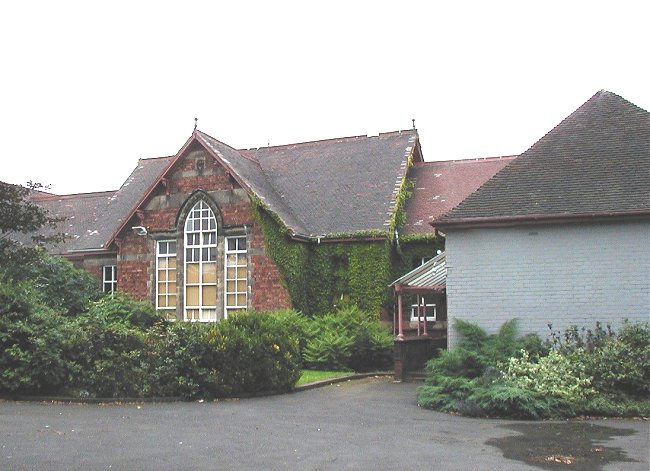
Slater Street school in a state of
dereliction. |
| The Local Board quickly responded and
the Darlaston School Board was
formed. Seats on it were eagerly contested in the
election that followed. The election battle was fought
between Nonconformists and the Church, with a resounding
victory for the Nonconformists. The members were as
follows: |
|
Enoch Horton – Chairman |
|
Joseph Corbett – Clerk |
|
G.P. Butler |
James Harper |
|
D. Etchells |
James Slater |
|
C. Green |
J. Shingleton |
|
J. Green |
Stephen Wilkes |
| Within four years the number of
school places available in the town had risen from 1,664
to 2,495. The schools in 1887 were as follows: |
| School |
Boys & Girls |
Infants |
Members
of Staff |
Old Church National School
Smith Street |
417 |
195 |
Mr. George Reed
Miss Hannah Howl
Miss M. Howl |
All Saints’ National School
Whitton Street |
275 |
120 |
Mr. John Wharton
Miss Mary White
Miss Emily Ayres |
St. Joseph’s Catholic School
Church Street |
115 |
- |
Miss Marie Jane Rose |
Wesleyan School
Pinfold Street |
307 |
208 |
Mr. William James
Miss Mary Baggott |
St. George’s Board School
St. George’s Street |
145 |
112 |
Mr. Henry Child
Mrs. E. Cuslace |
Central Board School
Slater Street |
392 boys |
200 |
Mr. J. E. Cherrington
Miss A. Grice
Ms. S. Williams |
|
For some years, Higher and
Technical Education Evening Classes were held in the
Town Hall during the winter months. They were
organised by the Higher Education Committee of the
Council. The Principal was Mr. Walter Macfarlane,
F.I.C., Committee Chairman; Councillor A. Slater,
B.A., Secretary of the Evening Classes; Joseph
Corbett, Assistant Secretary; and W. J. Carter. |
| Slater Street School
Originally the Central Board School,
which was built by the
School Board. It opened in July 1885 as a boys' school and was enlarged in 1893. The
first headmaster was Mr. J. E. Cherrington. On the first day
there were 29 children present in the morning and 33 in
the afternoon. For many years the school suffered from a
bad attendance record. It seems that both the children
and their parents had not grasped the importance of
education. Any excuse to stay away was taken. Such
events as Wednesbury wake or the local flower show were
a good excuse not to go to school.
Some of the children, whose parents worked in coal mines
or ironworks used what they called 'Saint Monday'
as an excuse to stay away on Mondays. Although parents
whose children were frequently absent would be reported
to the school attendance officer for truancy, and could
be taken to court and fined, little was actually
done to solve the problem. One group of children who
lived at Catherine's Cross were frequently absent and
became known as the 'Cross Gang'.
In 1915 an article appeared in a local newspaper
suggesting that the Staffordshire Education Committee
had decided to release thirteen year old boys from
school. Immediately thirty boys left the school and were
sent to work by their parents. It took a lot of effort
by the attendance officer to get them back to school
again. July became known as the 'Trip Season' because
children were often absent in order to attend outings
from local churches, chapels or public houses. Sometimes
older children were expected to stay at home to look
after younger brothers or sisters when their parents
went on a daily outing.
Another important factor affecting attendance was
illness. Every year there were outbreaks of the flue,
measles, chickenpox, smallpox, and scarlet fever. They
often reached epidemic proportions and resulted in the
closure of the school. In severe winters it was
difficult to keep the school warm because of the
inefficient heating system. Sometimes the school had to
be closed because of burst pipes.
In those days, many of the children were expected to
deliver their father's dinner at work, during the school
lunch break. In wet weather when they got 'soaked to the
skin', they would be kept home in the afternoon.
Sometimes children would stay away because they were
helping their father at work or had a part time job.
Some of them stayed away when they were working in the
hop fields when their parents went hop picking.
A few of the children were from poor families who were
unable to provide them with adequate food or decent
clothing. Some of them had sore feet because of a lack
of proper shoes. Others stayed away because they had no
shoes. A clothing fund committee sometimes visited the
school to help the poorest children. On at least one
occasion Mr. William Winn visited the school and
provided the poorest boys with a breakfast consisting of
tea and buns.
By the 1920s, several new practical subjects were
introduced including woodwork, gardening and bulb
growing. Many of the boys excelled at sport. The school
football team regularly won the Wednesbury and District
Challenge Shield and League Cup. In 1921 the relay team
won the relay race at Rubery Owen's sports day.
Joseph Evans, who was captain of the football team was
also captain of the England team in a schoolboy
international event and played against Scotland at
Glasgow.
Mr. Cherrington retired on
the 30th November, 1925. They were hard years, at a time
when many of the children were from poor families who
didn't value the education system and couldn't wait for
their children to start earning money for the family.
In the intervening years things
gradually got better, as people's standard of living
improved and attitudes changed.. The old slums
disappeared and people had higher expectations.
In 1958 part of the school was badly damaged after an
arson attack. As a result, a number of temporary
classrooms were built, which stayed in use until the
school closed.
Slater Street School closed in the mid 1960s
and continued to be used for a variety of purposes for
many years. Unfortunately the buildings suffered from a
series of arson attacks in February 2005 and as a
consequence were demolished at the beginning of March
2005. |
|
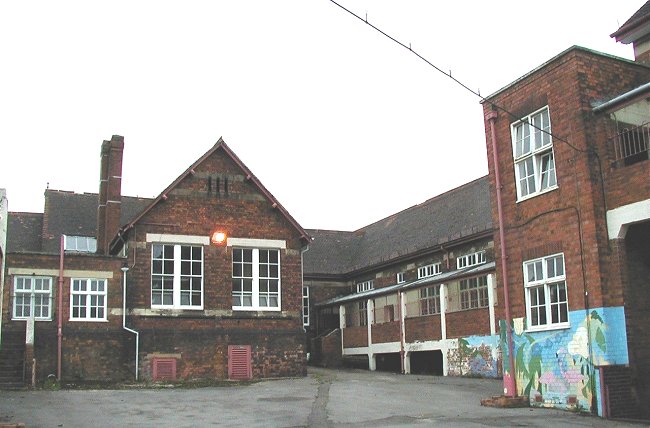
Slater Street School playground. |
|
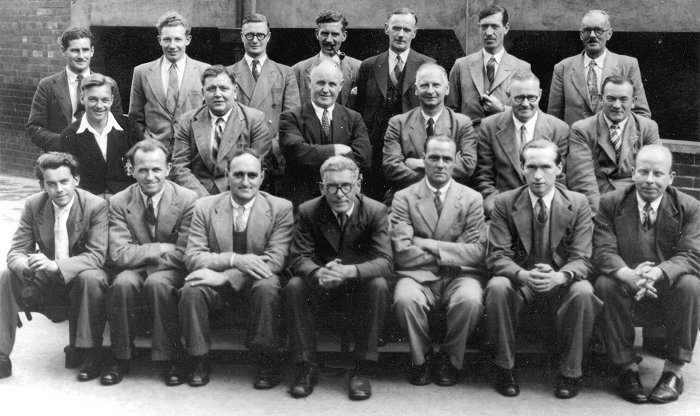 |
The teaching staff at Slater
Street School in the early 1950s. Courtesy of
Brian Groves. Thanks also to Lee Cadman. Left to
Right:
Back Row: Mr. Taylor (art), Mr.
Moore (P.E.), Mr. Lewis (music), Mr. Pounall
(woodwork), Mr. Pountney (English), Mr.
Leavesley, Mr. Anderson (science).
Middle Row: Mr. Williams (maths),
Mr. Morris (maths), Mr. Law (headmaster), Mr.
Hull (R.E.), Mr. Earnshaw (geography), Mr. Jones
(geography).
Front Row: Mr. Walker, Mr. Ellis
(music), Mr. Ayres (woodwork), Mr. Williams
(maths), Mr. Perry (metalwork), Mr. Harper, Mr.
Jenkins (History, English Literature).
If anyone has any further information
please
send
me an email. |
|
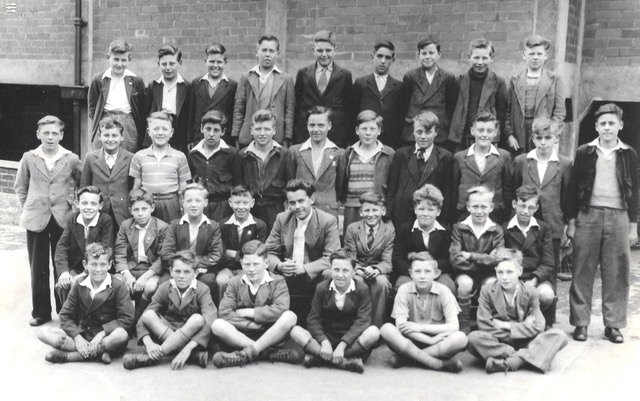
A class at Slater Street School in
1951 or 52. The teacher is Mr. Walker. Courtesy of
Norman Newton. |
|
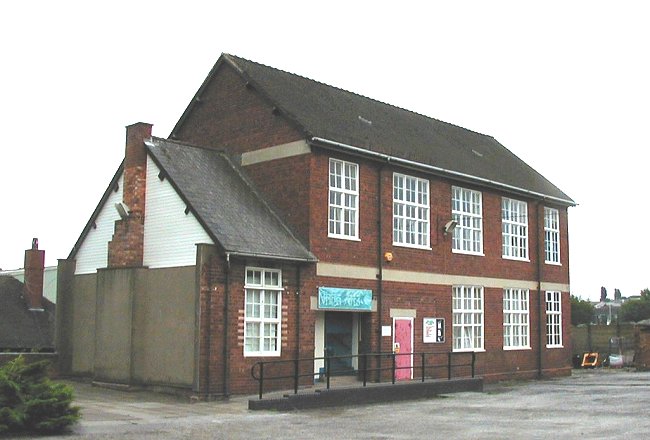
Slater Street Woodwork and
metalwork building in 2003. |
 |
Looking towards the entrance
on the right-hand side of Slater Street School in 2003. |
|
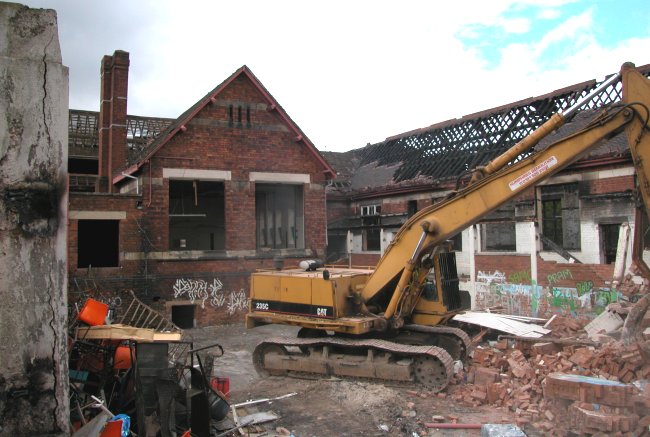
The demolition of Slater Street
School in 2005. |
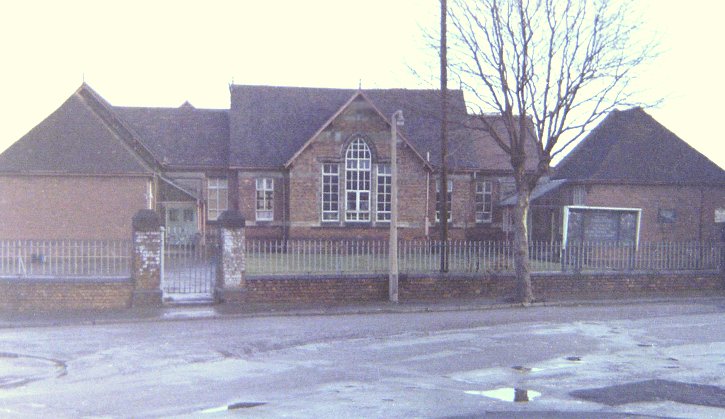
A final view of the front entrance to the
school.
| Slater Street
Junior School The school was often listed
in directories under Central Council Schools, along
with the senior boys school.
Bert Millington, who attended the school until 1945
has the following memories of the infants and junior
school, which was in-between the senior boys school
and Victoria Road.
When I entered the school, the Head was Miss Cook and
she was followed at a later date by Mr. Nicholls.
The
teacher for the reception class was Miss Pomeroy,
who had a large double room with a moveable screen
separating
the day to day activities from what was a large
playroom with toys and games beyond. During my six
years at the school
I also had the following teachers: Miss Fullwood,
Miss Jones, Mrs Page and Mrs Davenall. We took the
first 11 plus exam in 1945
and Ivor Taylor, Clive Gasser and myself passed for Wednesbury Boys
High School.
Mary Britton and another girl passed for Bilston
Girls High School.Some of the other youngsters in
our class were:
John Dean, Trevor Simmonds, Bernard Southam, Raymond
Walters, Desmond Parkins, Billy Tolley, Leonard
Parker, Walter Kent,
June Cadman, Marina Duckhouse, Jean Beechy and Joan
Evans.
I have many happy
memories of Slater Street
Infants and Junior School.
My time there coincided
exactly with World War 2. I
entered the first class
(Miss Pomeroy's) in 1939. In
1941 all the children were
taken to Station Street to
line the road and wave as
King George VI and Queen
Elizabeth visited Guest Keen
and Nettlefolds factory,
which was turning out war
equipment of various sorts.
I remember being somewhat
disappointed as the royal
car swept past and it was
difficult to see the
occupants.
At some point the school
also took in a number of
children who were evacuated
from London. I think it must
have been in the later
stages of the war rather
than the beginning, because
we questioned them over and
over about Doodlebugs and we
asked them to draw pictures.
I think other schools also
had groups of evacuees from
London.
Bert Millington |
|
|
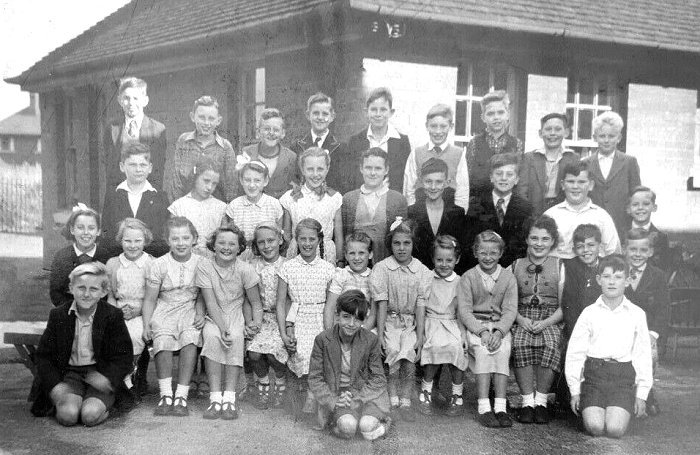
A class from
Slater Street Junior School in 1955. |
The following two
photos from Slater Street
Junior School were kindly sent by Dave Walters.

Class Group
1955/6. Courtesy of Dave Walters.
Back Row
David Bliss,
Christopher Rounds, Harry Tonks,
John Williams, George Young, Dennis
Webb, ??, Keith Jones, Kenny Staine?,
Barry Jordon, ??
Middle Row
Stewart
Jackson (or Bailey), Gary Prudence,
Dave Walters, Amanda?, ??, Judith
Penrice, ??,
John Saunders, Alfred Kent, Edward
Millard.
Front Row
Christine Fox,
Claire ?, (Maureen ?), Gwyneth
Roberts, Christine Whistance, Carol
Belcher, Muriel Davies,
??, ??, ??,
??, Christine Horton.
I can't
remember if Stewart was Jackson or
Bailey, but he lived in the house
next to the school on the other side
of the alley and his dad was the
swimming baths superintendant.
Judith Penrice
's dad was the Darlaston police
inspector (that's when we had a
police station.
Christine Fox,
Gary Prudence, Maurice Weston and
Harry Tonks lived in Bell Street.
Keith Jones lived in Foster Street
and Muriel Davies and Christine
Horton in Bush Street. |
|
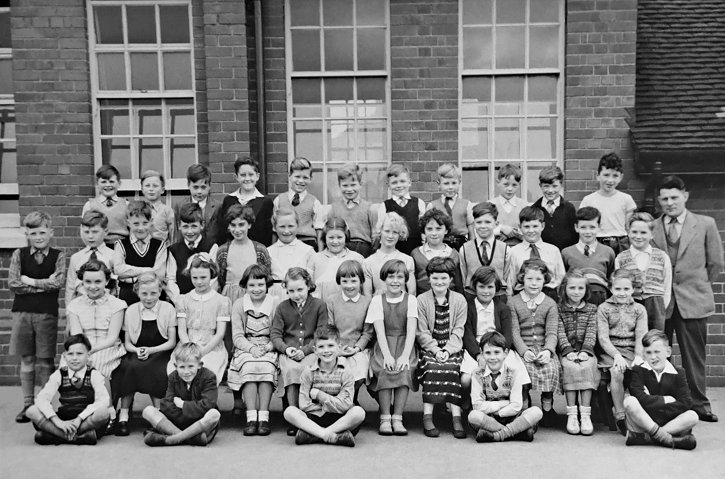
Class Group
1956/7. Courtesy of Dave Walters. |
If anyone has any memories of the school or
further information,
please contact
me. I will be delighted to hear
from you.
|
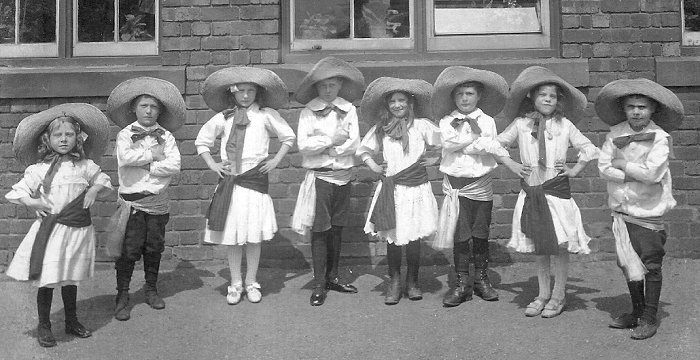
A lovely photo of a group of
children at a local school, year and school unknown.
One of them is possibly Henrietta Davis. Courtesy of
Gill Harding. If anyone can identify the location or
any of the children
please contact
me. |

Another lovely photo from Gill
Harding. Again the location and children's names are
not known. If anyone has any further information,
please contact
me. |
 |
Gladys Pomeroy school teacher at Slater Street
Infant & Junior School taken around 1952.
Courtesy of
Mrs Rowena Mattocks. |

Staff at Slater Street
Infants & Junior School taken in the late 1930’s
from left of right Mrs F Page, Miss Knight, Kath
Oliver, Miss Nell Fullwood and Dorothy Hicks.
Courtesy of
Mrs Rowena Mattocks. |
|
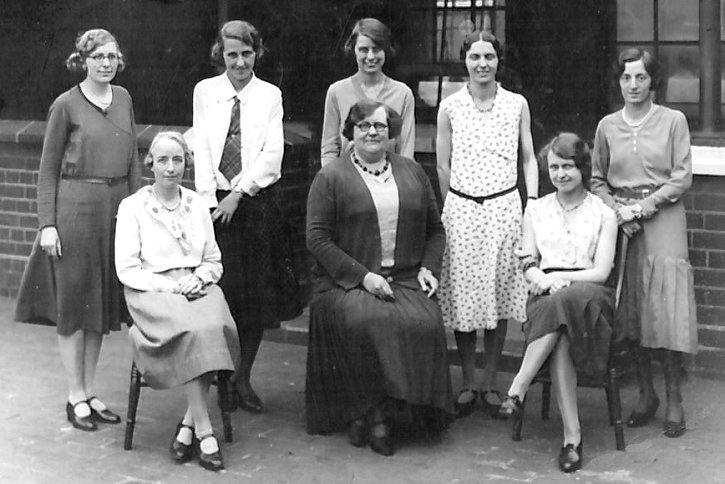
Back row centre Miss Nell Fullwood Slater Street
Infants & Junior School.
Courtesy of
Mrs Rowena Mattocks. |
|

Class of 1955-56 Slater Street Infants & Junior
School.
Courtesy of
Mrs Rowena Mattocks. |
|
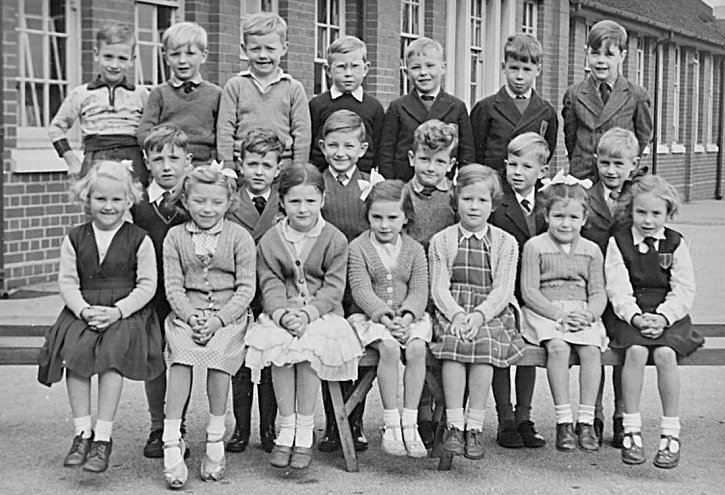
Slater Street Infants & Junior School (year
unknown).
Courtesy of
Mrs Rowena Mattocks. |
|

Slater Street Infants & Junior School Christmas
1947 teacher left Miss Nell Fullwood.
Courtesy of
Mrs Rowena Mattocks. |
 |
Mr. Hart the Caretaker with
Kaite the cat. At Slater Street Infants & Junior
School.
Courtesy of
Mrs Rowena Mattocks. |
|

Moxley School where Miss Nell Fullwood taught
before she left to go to college in 1928.
Courtesy of
Mrs Rowena Mattocks. |
 |
A
group of girls from std 1 class in the
playground at Slater Street Infants & Junior
School (year unknown).
In the background Darlaston baths
Courtesy of
Mrs Rowena Mattocks. |

Fifth from left Miss Nell Fullwood and seated
directly in front of Nell her sister Mrs Doris Hodson and their colleagues at Slater Street
Infants & Junior School.
Courtesy of
Mrs Rowena Mattocks. |
|
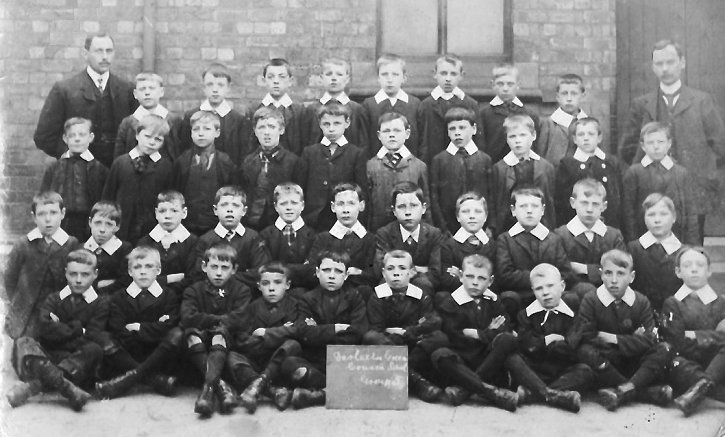
A class of boys from Darlaston Green School
headmaster Harold Percy Fullwood on the left.
Courtesy of
Mrs Rowena Mattocks. |
|

A class of boys from Darlaston Green School
headmaster Harold Percy Fullwood on the
right.
Courtesy of
Mrs Rowena Mattocks. |
|
St. Lawrence’s School
Often called the
Parish Church School opened in April 1869 when the old
school established in 1836 in the graveyard was
demolished. The buildings were enlarged twice within the
first 20 years and the school possessed a good
playground. In 1880 evening science classes began and
were attended by 165 students.
St. George’s Board School
Opened in
1844 as a Sunday school and was handed over to the
School Board in 1883. An new school was built in 1894 at
a cost of £5,550.
All Saints’ National School
Opened in July
1874 with an infants department at James Bridge built in
1894.
The Wesleyan School
Opened in 1846
as a Sunday School. It was built by Thomas Adams at a
cost of £439.19s.6d. and designed by G.W. Green. It
became a day school under Government inspection in 1860
and was enlarged and improved. In 1865 there were
approximately 100 pupils and by 1901 the number had
risen to 479.
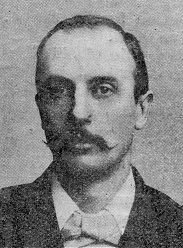
Mr. Harold P. Fullwood. Headmaster of the
Wesleyan School in 1901. |
|

Miss Baggott. Infant Mistress of the
Wesleyan School, in 1901. |
St. Joseph’s Catholic School
The school was
founded in 1875 in Church Street and rebuilt in 1964 in
Rough Hay Road. The buildings were expanded in the 1980s
and a new nursery opened in 1993, and enlarged in 2002.
Dorsett Road School
Dorsett Road School was the first
of a new generation known as the 'Staffordshire Type' of
school. It opened in February 1907 but was very
different from the earlier types of school building,
featuring better ventilation without draughts, more
compact construction, and very economical running. It
created a more healthy environment than in the other
overcrowded schools of the day. A visiting school
inspector remarked after a visit on a cold February day:
I could see how the ventilation was working. It was a
cold day, and there was some snow. It was remarkable
that when I walked into the classrooms there was no
smell.
The school was enlarged in 1911. In
traditional schools, illnesses such as coughs and colds
could quickly spread, resulting in poor attendances. At
Dorsett Road there were no classroom
smells, so everyone felt fresher at the end of the day.
The new type of school was designed by Dr. Reid, the
County Medical Officer, and the architects, who
collaborated to produce a healthier environment for the
children. They had clearly come up with the right
solution because many such schools were built throughout
the country. Darlaston still has one school of this
type, Salisbury Street J.M.I.
The 1912 Kelly's Staffordshire
directory lists three teachers: Master: Mr. Albert D.
Fullwood J.P.; Mistress: Miss Mary Millner; and Infants'
Mistress: Miss Jane Wyatt B.A. The school was by far the
largest school in the town, with accommodation for 1,140
pupils, twice as big as any other.
In the late 1920s and early 1930s,
several government reports were produced by a number of
committees, under the chairmanship of Sir William Henry
Hadow. They became known as the Hadow Reports, and had a
great impact on education at the time. The reports
recommended a division of elementary schools into
primary schools for children under the age of 11, and
senior schools for older children. This necessitated the
building of many new schools including Pinfold Street
Primary School, and Rough Hay School.
In the mid 1930s the decision was
taken to close Dorsett Road School and transfer the
pupils elsewhere. When Pinfold Street Primary School opened in September
1936, a large number of pupils moved there. Others went to Old Church School, Slater Street
School, Salisbury Street School, and Rough Hay Primary
School.
Dorsett Road School finally closed
in 1939 and was acquired by Longmore Brothers in order
to extend their site. Many of the school buildings were
soon demolished, others survived until the 1970s. All
that remains today is a short length of the old school
boundary wall in Dorsett Road
Terrace, which divides the newly built Woods Bank estate
from the end house in the Terrace.
|
|

All that remained of
the school in 1965. Courtesy of Bill Beddow. |
|
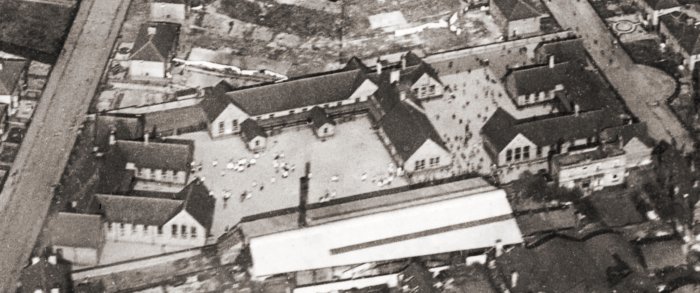
Dorsett Road
School in the 1920s. |
|
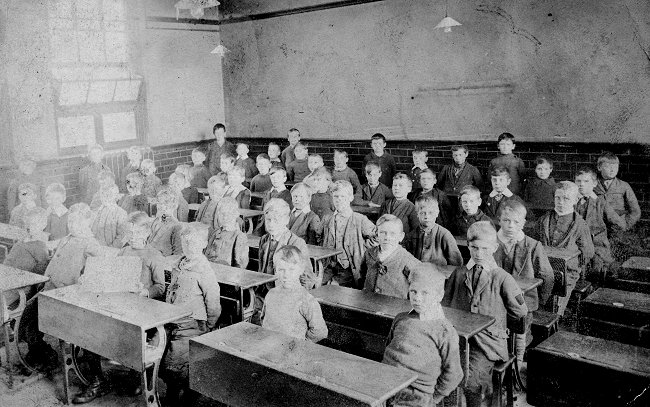
A class of boys at
Dorsett Road School in about 1910. From an
old postcard. |

A class of boys at
Dorsett Road School in about 1918. The
teacher on the left is Miss Clapham, the
teacher on the right is Mr. F. W. Forward.
5th from the left in the first row standing
is Richard Ashmore. Courtesy of John and
Christine Ashmore. |
|
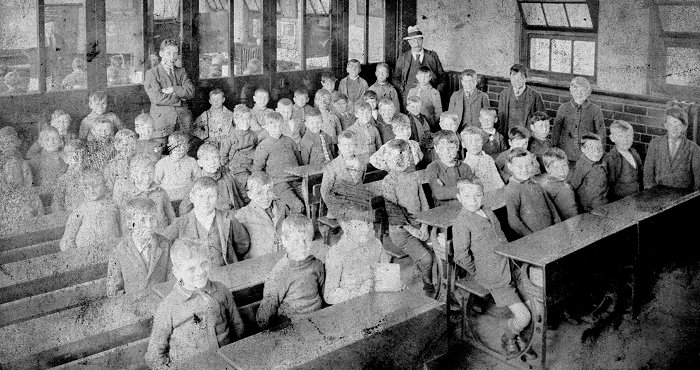
A class of boys at
Dorsett Road School in about 1919. In the
centre at the back is Mr. F. W. Forward. |
|

A class of seven year
olds at Dorsett Road School. |
|

Another class at the
school, with head teacher Miss Rees on the
left. |
|
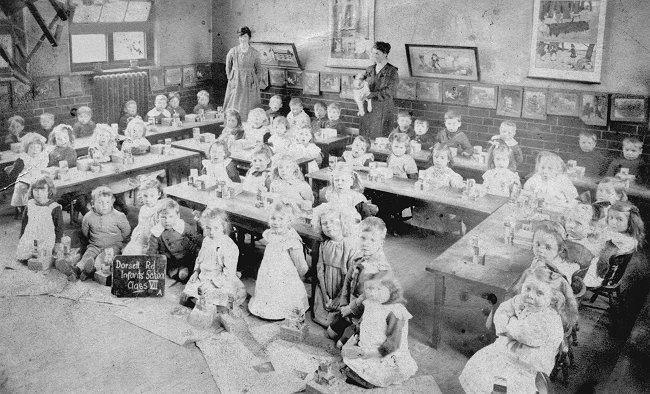
Dorsett Road infants
class 7 (five year olds) from around 1919.
The lady in the background with the dog is
head teacher Miss Rees. To her left is class
teacher Miss Crowson. From an old postcard. |
|
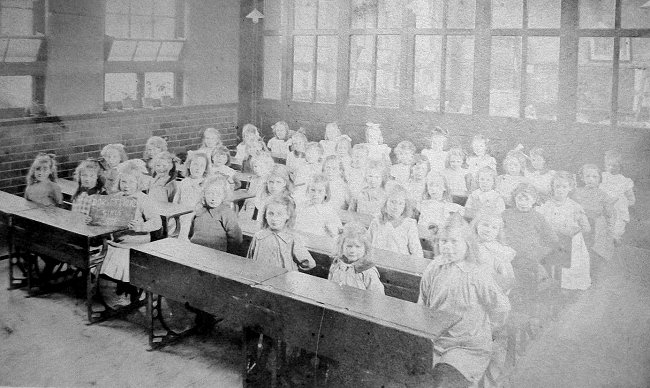
A class of girls at
Dorsett Road School in about 1919. From an
old postcard. |
|
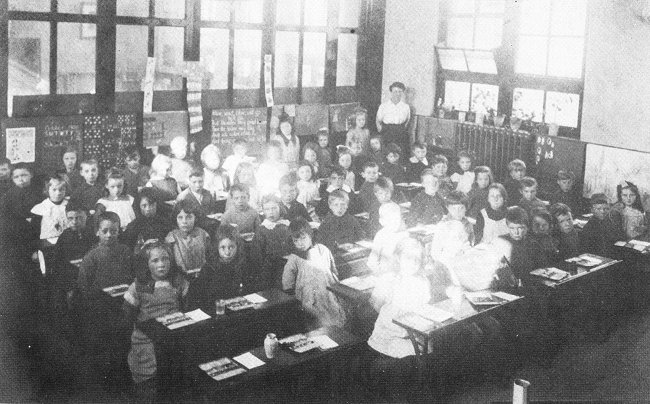
A class at Dorsett
Road School in 1920. |
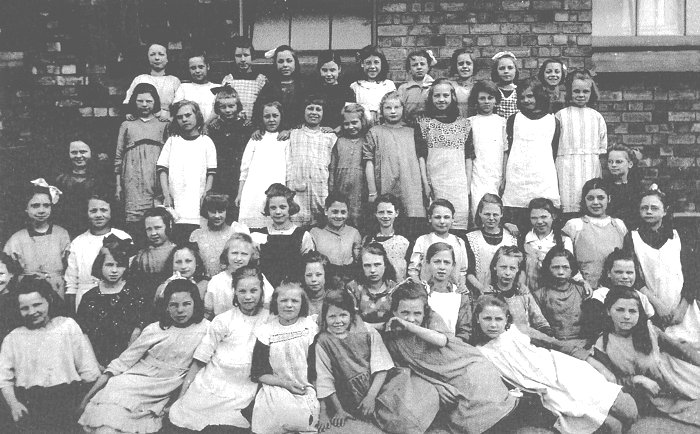
A class of girls
at Dorsett Road School, in about 1920.
On the second row from the front, on the
far left with a large bow in her hair is
Emma Sylvia Bott. Courtesy of Madeleine
Freelove.
Emma Sylvia Bott was born on
the 22nd May, 1911 in Peartree
Terrace, off New Street. |
|
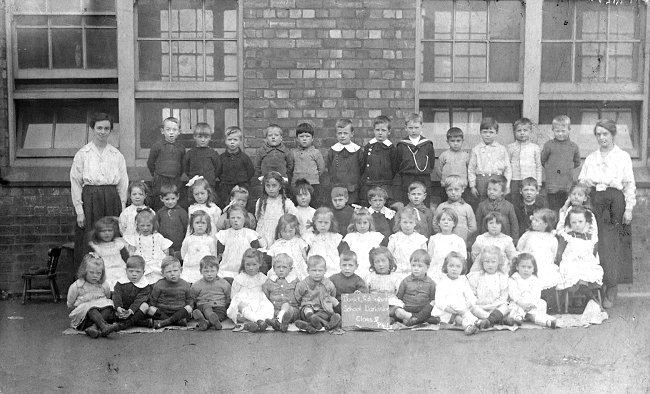
A mixed class of
children at Dorsett Road School in the
1920s. On the right is head teacher Miss
Rees. Courtesy of John and Christine Ashmore. |
|
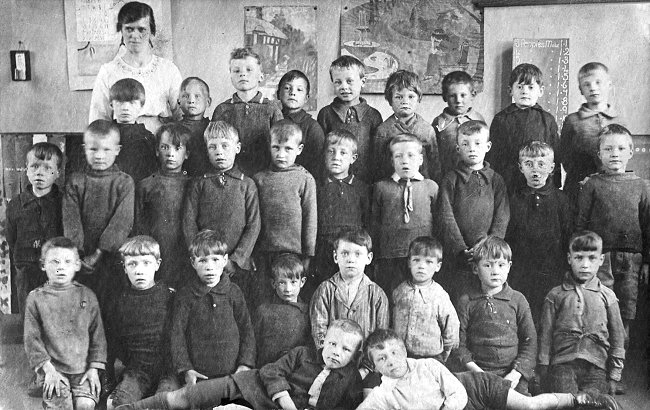
A class of boys at
Dorsett Road School in the 1920s. Courtesy
of John and Christine Ashmore. |
|
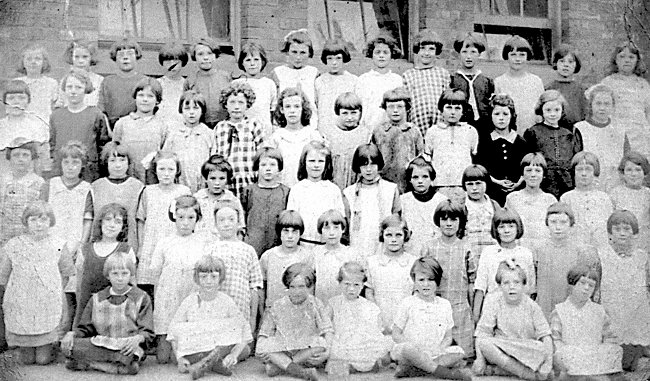
A girl's class at
Dorsett Road School in 1927. Fifth from the right,
on the third row from the front is Rose
Flavell. |
Pinfold Street Primary School
|
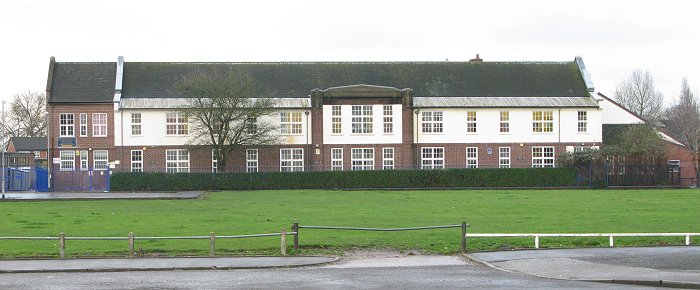
Pinfold Street Primary School. |
| |
|
| Read the
history of Pinfold Street School |
 |
| |
|
| Rough Hay Primary
School Rough Hay Primary School officially
opened on Tuesday 14th May, 1940, as part of
the education reforms instigated by Sir
William Henry Hadow. Many of the new pupils
had been transferred from the old Dorsett
Road School. |
|
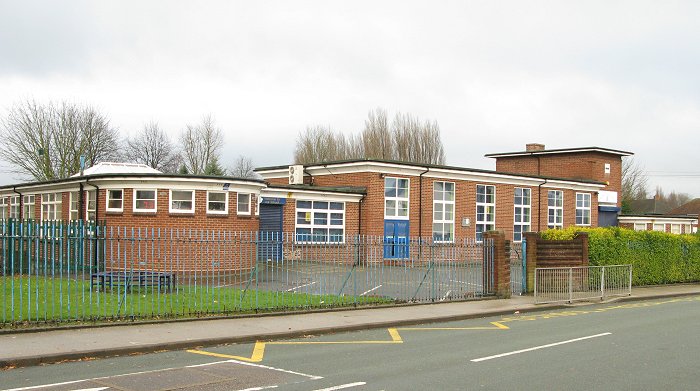
Rough Hay Primary
School. As seen in 2007. |
| The school had a nursery, which became
an infants department. There were separate
playgrounds for infants and juniors. In the
1970s much of the school was refurbished,
and a new layout introduced. |
|

A class from
the mid to late 1940s. On the
extreme left is Derek Groves. |
|

Another photograph taken in the
same classroom, possibly on the
same day as the one above. Courtesy of Keith Robinson. |
|
If you can name anyone in the
photographs above, or have any photographs I can
include here, or have any information about the
school, please
send
me an email.
Moxley Primary School
Moxley Primary School officially opened as
the 'County Infants School' on 26th March,
1928. It was built in 1927 by Thomas Jones,
and designed by Joynson Brothers of
Darlaston, in response to the 1926 Hadow
report. The total project including the
purchase of the land, building of the
school, equipment and furniture cost £8,600.
The school
was officially opened by William Henry
Wesson, Mayor of Wednesbury, and owner of
the nearby Victoria Ironworks. There were
initially five classrooms of approximately
the same size that were accessed from the
rear corridor, in which was the main
entrance, and two entrance lobbies. In the
early 1960s and early 1970s, extensions were
added at the back of the school.
The school
closed in November 2006 following its
amalgamation with the Dorothy Purcell Junior
School in Bull Lane. The amalgamation was
due to falling pupil numbers at each school.
The school in Bull Lane then became
Moorcroft Wood Primary School. The 1960s and
1970s extensions were demolished in 2009
following a fire. The main building itself
was demolished in August 2010. |
|
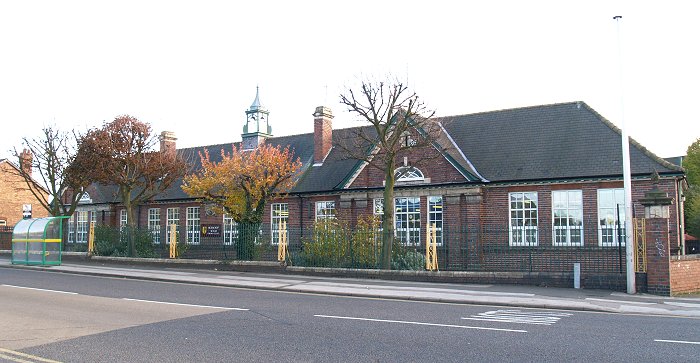
The school in 2006, then called
Moorcroft Wood Primary
School. |
|
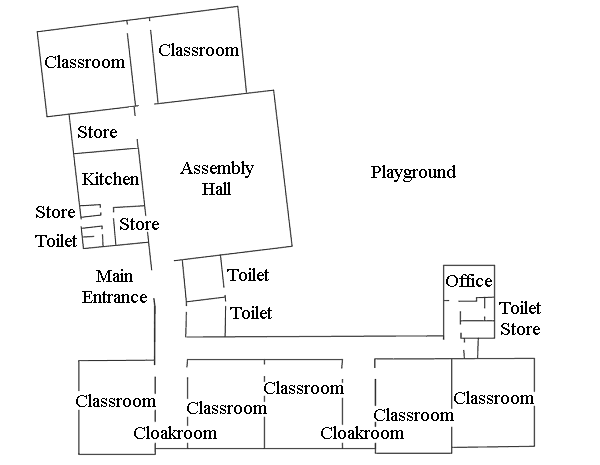
A plan of the school
with the later extensions. |
|

The school in
2007, after closure. |
|
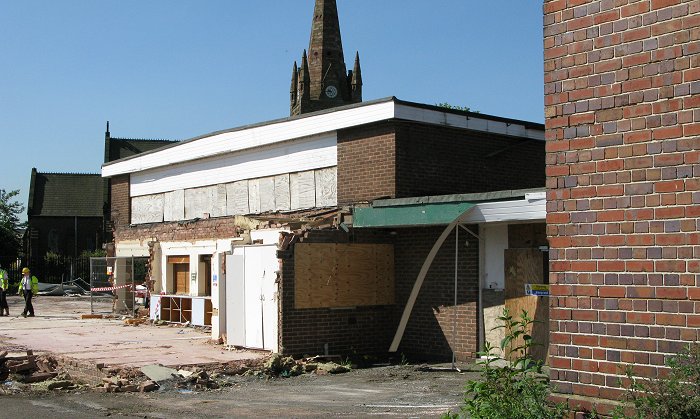
The assembly hall
during demolition in 2009. |
|
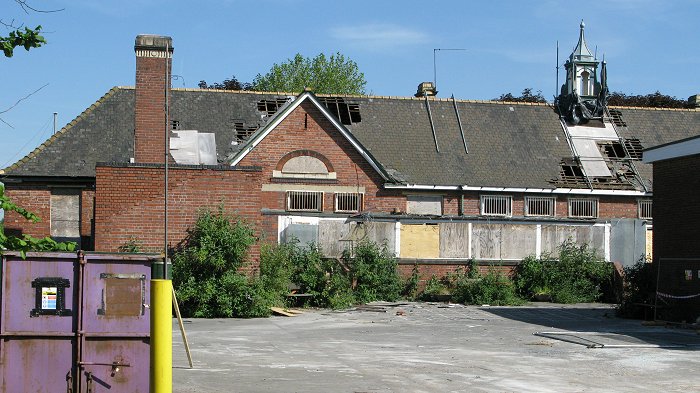
Another view of the
school in 2009. |
|

A final view, taken
after the demolition of the rear extension. |
|
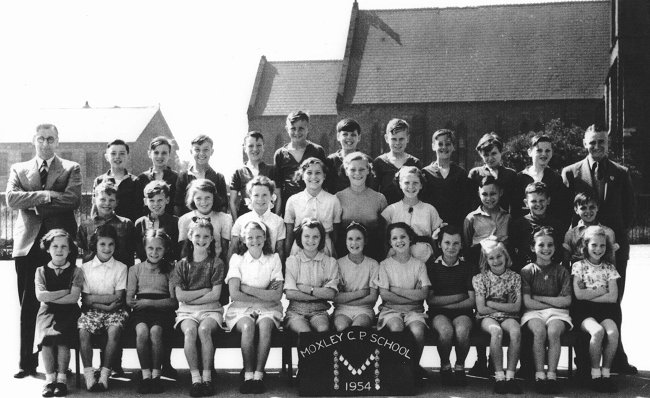
A class photograph taken
at Moxley Primary School in 1954. Courtesy of
Ken Phillips.

A class photograph
taken at Moxley Primary School in 1955.
Seated in the centre behind the trophies
is Mr. Warner. Courtesy of Ken Phillips. |

A class photograph taken at Moxley Primary
School in 1956. Courtesy of Ken Phillips.
King's Hill School
| |
|
Read
about King's Hill Primary
School and view
some photographs |
 |
| |
|
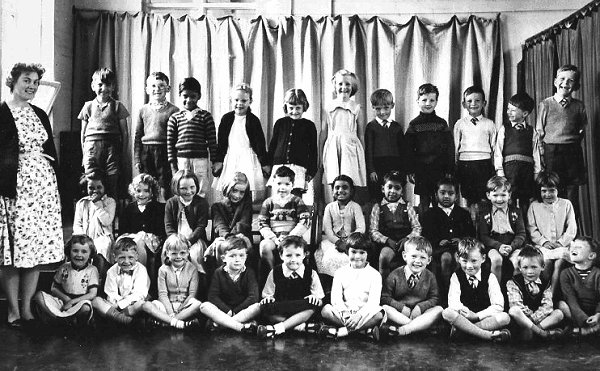
This
photograph was kindly sent by
Rob Pheasant, who is 2nd from
the right on the middle row. The
photograph was taken at King's
Hill infants school in 1962.
Back
row left to right: Roger
Yarnell, Kevin Smith, (Unknown),
Nanette Walls, (Unknown),
(Unknown), Nigel Foster, Paul
Wright, Adrian Read, David
Adams, Andrew Bourne.
Middle row left to right:
Anita Gosh, Karen Holland,
Pauline Perry, Anne Willoughby,
Kevin Groves (Unknown),
(Unknown), (Unknown), Robert
Pheasant, Judy Hogan.
Front row left to right:
Kathleen Jones, William Wilkes,
(Unknown), (Unknown), Vivian
Birch, Susan Carlas, Andrew
Peach, (Unknown but Andrew
Peach’s brother), Walter Kent,
Barry Cooper.
The teacher was Miss Cooper.
|
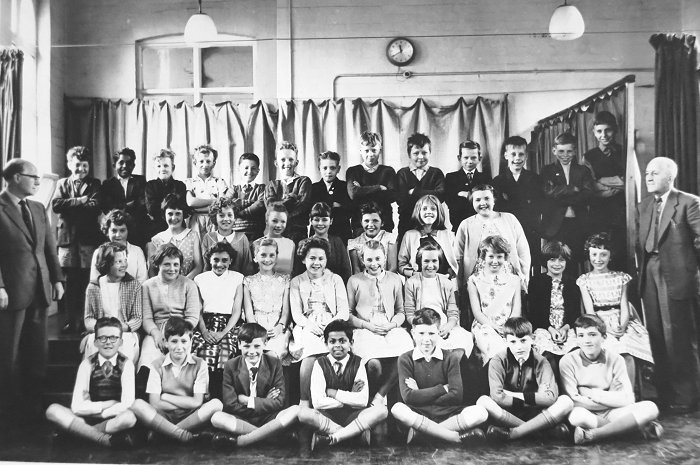
Another
class photograph taken at King's
Hill infants school. This one is
from around 1960. Courtesy of
Sylvia Peters. Last but one on
the second row is Sylvia Platt,
and next to her at the end of
the row is Carol Parker.
|
If anyone has any
other photos taken at the school
(infants, juniors, or seniors)
please
send me an email.
Salisbury Primary School was Salisbury
Street Secondary Modern Girls' School in the
1950s. The following photo from that time
shows the school staff:

Back
Row, left to right: Mr.
Davies, ? , Miss Spedding, ? ,
Mrs Ashcroft, Miss Lowe, Miss
Bosworth, ? , Mr. Wilkins, Mr.
Ellis.
Front Row, left to right:
Mrs Harper, Miss Goodreid, Miss
B. Jones, Miss Garrington, Miss
Keatley (headmistress), Miss
Skinner, Mrs Barnett, Miss
Barnett (no relation), Mrs
Hodson (secretary). |

A school play at
Salisbury Street.
|
 |
 |
 |
Return to
A New Town Hall |
Return to
Contents |
Proceed to
Close of the Century |
|